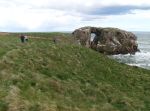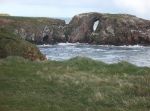The "Bullers" of Buchan
To get to them we parked near the road and walked out through the amazing  gorse (who knew it smelled like coconut?), and then
gorse (who knew it smelled like coconut?), and then  along the coast to the north; as we
along the coast to the north; as we  got nearer you could see
got nearer you could see  this amazing
this amazing  rock formation
rock formation  ,
with a cave under it (which it was really difficult to get a useful photograph
of) and steep
,
with a cave under it (which it was really difficult to get a useful photograph
of) and steep  cliffs
cliffs  behind it.
behind it.
Here's what Samuel Johnson said about it, in 1775:
". . . we soon turned our eyes to the Buller, or Bouilloir of Buchan,
which no man can see with indifference, who has either sense of danger
or delight in rarity. It is a rock perpendicularly tubulated, united on
one side with a high shore, and on the other rising steep to a great height,
above the main sea. The top is open, from which may be seen a dark gulf
of water which flows into the cavity, through a breach made in the lower
part of the inclosing rock. It has the appearance of a vast well bordered
with a wall. The edge of the Buller is not wide, and to those that walk
round, appears very narrow. He that ventures to look downward sees, that
if his foot should slip, he must fall from his dreadful elevation upon
stones on one side, or into water on the other. We however went round,
and were glad when the circuit was completed.
"When we came down to the sea, we saw some boats, and rowers, and resolved
to explore the Buller at the bottom. We entered the arch, which the water
had made, and found ourselves in a place, which, though we could not think
ourselves in danger, we could scarcely survey without some recoil of the
mind. The bason in which we floated was nearly circular, perhaps thirty
yards in diameter. We were inclosed by a natural wall, rising steep on
every side to a height which produced the idea of insurmountable confinement.
The interception of all lateral light caused a dismal gloom. Round us was
a perpendicular rock, above us the distant sky, and below an unknown profundity
of water. If I had any malice against a walking spirit, instead of laying
him in the Red-sea, I would condemn him to reside in the Buller of Buchan.
"But terrour without danger is only one of the sports of fancy, a voluntary
agitation of the mind that is permitted no longer than it pleases. We were
soon at leisure to examine the place with minute inspection, and found
many cavities which, as the waterman told us, went backward to a depth
which they had never explored. Their extent we had not time to try; they
are said to serve different purposes. Ladies come hither sometimes in the
summer with collations, and smugglers make them storehouses for clandestine
merchandise. It is hardly to be doubted but the pirates of ancient times
often used them as magazines of arms, or repositories of plunder." [A
Journey to the Western Isles of Scotland]
Boswell also described it:
"We got immediately into the coach, and drove to Dunbui, a rock near
the shore, quite covered with sea-fowls; then to a circular bason of large
extent, surrounded with tremendous rocks. On the quarter next the sea,
there is a high arch in the rock, which the force of the tempest has driven
out. This place is called Buchanís Buller, or the Buller of Buchan, and
the country people call it the Pot. Mr Boyd said it was so called from
the French Bouloir. It may be more simply traced from Boiler in our own
language. We walked round this monstrous cauldron. In some places, the
rock is very narrow; and on each side there is a sea deep enough for a
man of war to ride in; so that it is somewhat horrid to move along. However,
there is earth and grass upon the rock, and a kind of road marked out by
the print of feet; so that one makes it out pretty safely: yet it alarmed
me to see Dr Johnson striding irregularly along. He insisted on taking
a boat, and sailing into the Pot. We did so. He was stout, and wonderfully
alert. The Buchan-men all shewing their teeth, and speaking with that strange
sharp accent which distinguishes them, was to me a matter of curiosity.
He was not sensible of the difference of pronunciation in the south and
north of Scotland, which I wondered at.
As the entry into the Buller is so narrow that oars cannot be used as
you go in, the method taken is to row very hard when you come near it,
and give the boat such a rapidity of motion that it glides in. Dr Johnson
observed what an effect this scene would have had, were we entering into
an unknown place. There are caves of considerable depth; I think, one on
each side. The boatmen had never entered either of them far enough to know
the size. Mr Boyd told us that it is customary for the company at Peterhead
well, to make parties, and come and dine in one of the caves here." --
Journal of a Tour to the Hebrides
But what we could just see back down
the coast was even more amazing.
Back to May 2009
Back to Hunts News
 gorse (who knew it smelled like coconut?), and then
gorse (who knew it smelled like coconut?), and then  along the coast to the north; as we
along the coast to the north; as we  got nearer you could see
got nearer you could see  this amazing
this amazing  rock formation
rock formation  ,
with a cave under it (which it was really difficult to get a useful photograph
of) and steep
,
with a cave under it (which it was really difficult to get a useful photograph
of) and steep  cliffs
cliffs  behind it.
behind it.